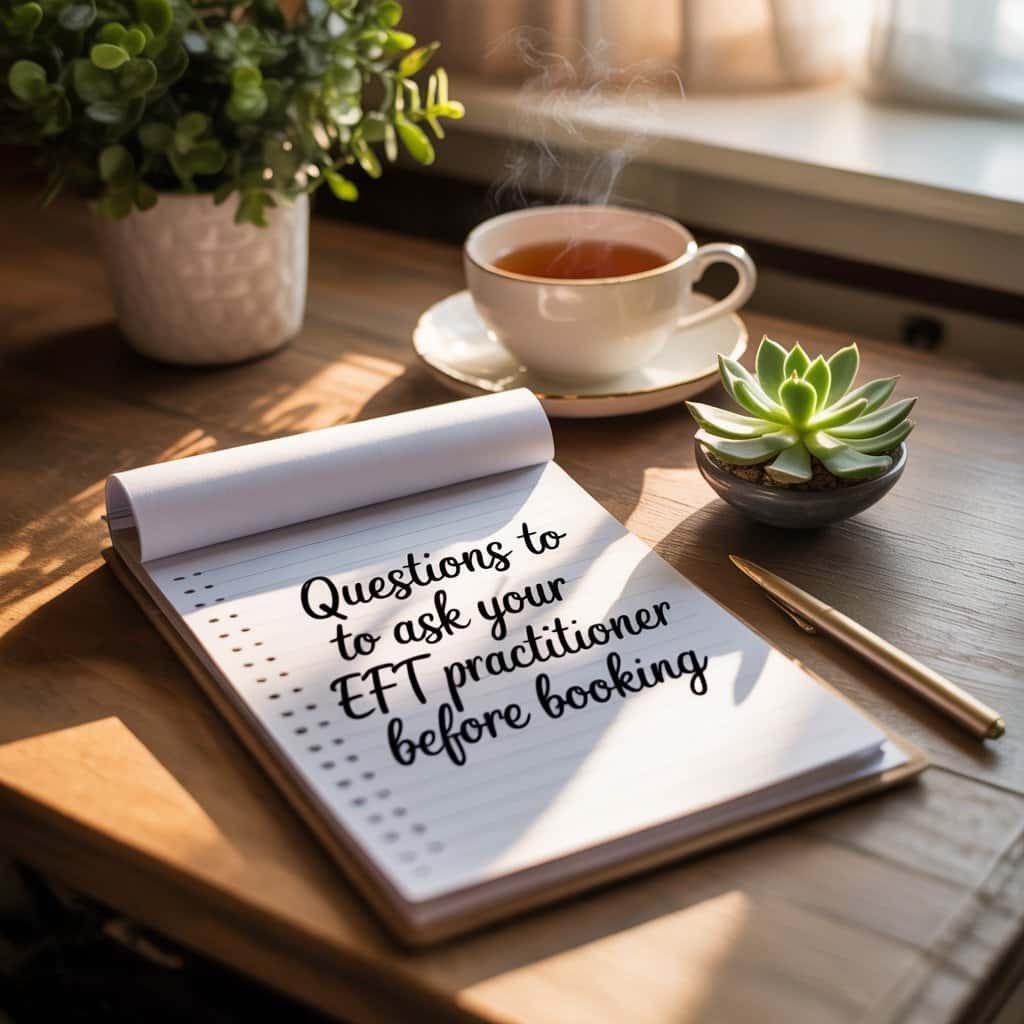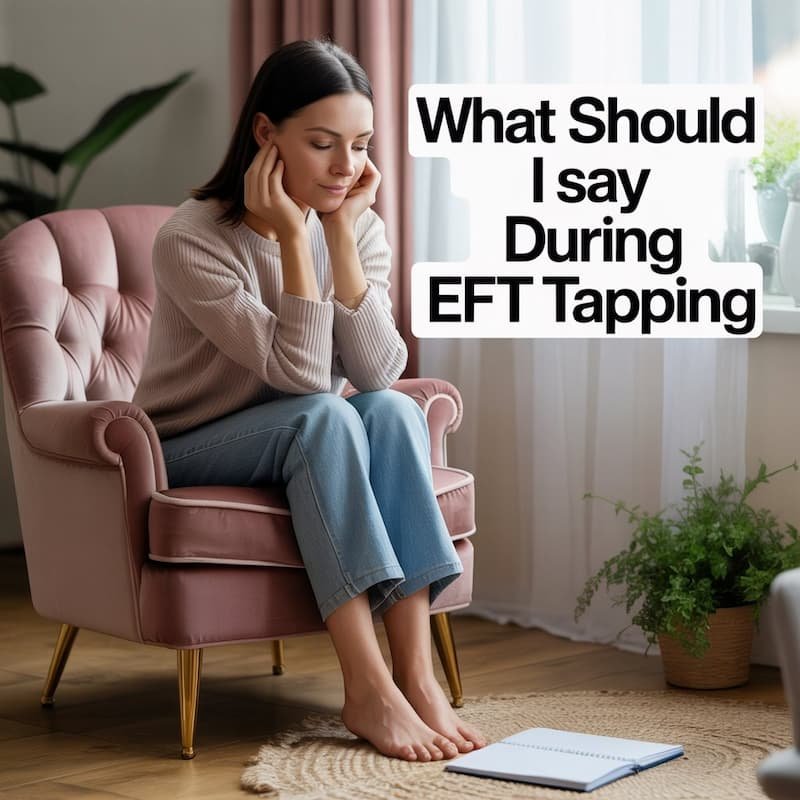How I Use EFT Tapping to Calm Anxiety (And How You Can Too)
Anxiety is one of those emotions that can sneak up on you, sometimes without warning, and completely take over your body and mind.
Your chest tightens, your heart races, your thoughts spiral, and your energy drains away as though you’ve been carrying a heavy weight all day. I know this feeling intimately.

When I was working in high-pressure jobs, there were days when my heart would race so fast that I genuinely thought something was physically wrong with me.
My body would tense up from head to toe, my hands would go cold, and my mind would spiral in every direction. That is the uncomfortable, overwhelming, and sometimes paralyzing reality of anxiety.
This is exactly when I found EFT tapping to be a lifeline.
What Is EFT Tapping for Anxiety?
EFT, or Emotional Freedom Techniques, is a simple yet powerful tool that helps release emotional blocks.
It combines gentle tapping on specific energy points on your body with acknowledging and speaking your emotions out loud.
Unlike medications or therapies that take weeks to show results, EFT can provide almost immediate relief, even if temporary, from the physical and emotional symptoms of anxiety.
One thing I quickly realized is that anxiety isn’t a one-size-fits-all feeling.
Generic tapping scripts that you might find online can be somewhat helpful, but for real, noticeable relief, it’s essential to work with the specific emotions you are feeling in the moment.
Why Awareness Is Key?
Before tapping, it’s crucial to identify exactly what you’re feeling. For me, much of my anxiety stemmed from fear of failure and lack of support.
I felt like I had failed in life, and there was no one I could confide in who would truly understand or support me.

That fear of judgment and consequences spiraled into racing thoughts, tension in my body, and a feeling of helplessness.
Other sources of anxiety for me came from overwhelm and trying to do too much in one day. When stress depletes your energy, even small tasks can feel impossible.
Recognizing these triggers is the first and most important step in using EFT effectively.
How to Do EFT Tapping for Anxiety?
Here’s how I approach tapping for anxiety. Keep in mind: the process is iterative, and patience is essential.
Step 1: Setup
Start by tapping gently on the karate chop point (the side of your hand). Say three times:
- “Even though I feel this anxiety right now, I accept myself completely.”
- “Even though my heart is racing and my body feels tense, I choose to be gentle with myself.”
- “Even though this fear is overwhelming, I am here, tapping, and taking care of myself.”
Step 2: Identify and Rate Your Emotions
Now comes a crucial step: identify the emotion or feeling you’re experiencing and rate its intensity on a scale from 0 to 10.
For example, if your anxiety feels extreme, you might start at an 8 or 9. This rating is your benchmark.

Step 3: Tap Through the Points
Tap through the standard EFT points, speaking aloud about the emotion:
- Eyebrow: “This anxiety feels so heavy.”
- Side of Eye: “My chest is tight, my heart is racing.”
- Under Eye: “I feel so overwhelmed and tense.”
- Under Nose: “This fear is uncomfortable.”
- Chin: “I feel powerless and worried.”
- Collarbone: “My mind won’t stop racing.”
- Under Arm: “I feel stressed and fearful.”
- Top of Head: “And yet, I am here, taking care of myself, one tap at a time.”
Feel free to replace the sentences with your own symptoms and emotions. You do not have to strictly follow the script, the script gives you an idea of what to say during eft tapping.
Step 4: Check Your Intensity and Record New Emotions
Pause, take a deep breath, and check your rating again. Often, tapping on one emotion will bring up another related emotion or memory.
Write it down, rate it on the 0–10 scale, and do another round of tapping for that specific feeling.
This process may bring up multiple layers, anxiety about work may trigger fear about the future, guilt, or even sadness.
Tap through each new emotion, always rating the intensity and tracking your progress.
Step 5: Repeat Rounds
Depending on the intensity of your anxiety, you may need several rounds of tapping, each lasting 5–10 minutes.
Some sessions may take up to an hour if the anxiety is strong or has multiple layers.
The key is persistence and self-compassion. You are rewiring your emotional response, not forcing it to disappear instantly.
Step 6: Rest Between Rounds
Once you feel noticeably lighter or calmer, take a short break before starting another round.
This allows your nervous system to settle and ensures that your body and mind are ready to process the next set of emotions.
My Personal Experience With Anxiety
In my own life, high-pressure jobs would often trigger extreme anxiety. My heart would race, my thoughts would spiral uncontrollably, and my body would tense up like I had been holding my breath for hours.
Before EFT, I would distract myself or hope the feeling would pass, it rarely did.

Once I started using EFT, I learned the power of acknowledging my emotions while actively tapping.
Within minutes, my heart would slow down, my chest would feel lighter, and my thoughts became more manageable.
Over time, repeated practice allowed me to catch anxiety early, preventing it from escalating into panic or overwhelm.
Why EFT Tapping Works
Many tools for anxiety focus on distraction or temporary relaxation. EFT is different because it goes straight to the root of the emotional block.
It works on specific events, fears, and patterns rather than just calming the body temporarily.
Even when emotions feel stuck, EFT provides a safe way to release them. And when paired with guidance from a skilled practitioner or practiced consistently on your own, it becomes an invaluable tool for long-term emotional regulation.
Final Thoughts
EFT tapping isn’t about eliminating anxiety permanently, it’s about giving yourself the ability to respond instead of react. It allows you to acknowledge, feel, and release emotions safely and effectively.
If you’re experiencing racing thoughts, chest tightness, or waves of panic, I encourage you to try EFT.
Set aside an hour or so, work through your emotions, track your intensity from 0–10, and repeat rounds until you feel relief.
Remember, even temporary relief is powerful, it allows you to breathe, think clearly, and regain control.
With regular practice, EFT can become your personal tool for managing anxiety in real time, helping you feel calmer, lighter, and more centered.
And if you feel stuck or want guidance, working with an experienced EFT practitioner, even online can help you navigate intense emotions and release blocked energy safely and effectively.
Disclaimer: The content on this page is for educational and informational purposes only. EFT (Emotional Freedom Techniques) is not a substitute for medical, psychological, or psychiatric treatment. Please consult a licensed professional for any medical or mental health concerns.






